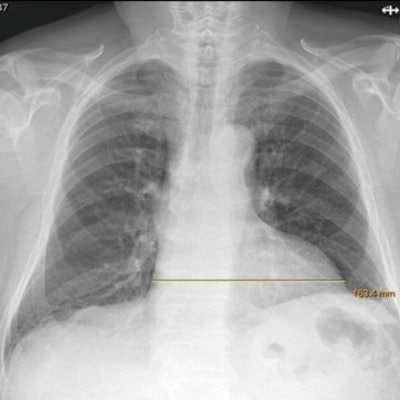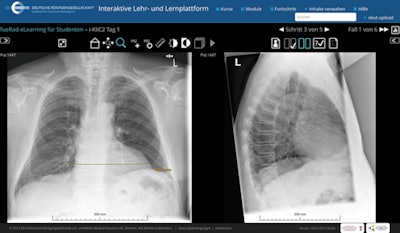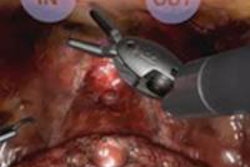
Trainees and medical students at Germany's Tübingen University can now experience radiology digitally. The TueRad e-learning platform lets them work on specific cases and gives them a realistic picture of what radiology is all about. In this interview, Dr. Mike Notohamiprodjo, a professor in the department of diagnostic and interventional radiology, talks about the origins of the project, its future potential, and the support it has received from the German Radiological Society (DRG, Deutsche Röntgengesellschaft).
DRG: What is TueRad?
Notohamiprodjo: It's a digital learning platform that lets students work on online radiological cases.
 TueRad e-learning on the DRG platform. All images courtesy of the DRG.
TueRad e-learning on the DRG platform. All images courtesy of the DRG.How did you come up with the idea of creating such a platform?
It actually came from my students. I was examining some anatomical specimens in the MRI section with the help of some anatomy students, and I asked what they thought of radiology. They said they really enjoyed it, but it was very underrepresented on the course. Also, the exams usually happened a long time after they'd studied it, by which time they'd forgotten most of what they'd learned.
I thought that was a very valid point and I wondered why, as radiologists, we hadn't done something about it a long time ago. After all, radiology is an entirely digital subject, so it was ideally suited to e-learning.
That set me thinking. I asked the DRG whether such solutions existed, and they said they were working with Dr. Fabian Bamberg on an e-learning platform specifically tailored to the needs of radiology. By coincidence, Fabian's office is only a few doors away from mine, and I soon realized the DRG platform was the perfect way of teaching radiology to students at Tübingen.
What exactly can the students do with TueRad e-learning? What are its advantages?
They can work on case studies with all the functionality of a PACS workstation, and view high-resolution images with no clues or markings, as you would see in most textbooks. Radiology is much more fun if you solve problems yourself. Another advantage is that we can explore specific course subjects in more depth, and repeat them if necessary.
How did the university react to the idea of using e-learning in radiology?
They're significantly expanding their e-learning provision, so the idea was a perfect match. They actually gave us a significant grant that enabled a physician to devote an entire year to the project. We are working closely with the faculty on incorporating e-learning into the course and evaluating it scientifically.
Is radiology leading the way in terms of e-learning at Tübingen?
Yes, it is. There are other learning platforms in the German-speaking countries, but TueRad has the big advantage of being supported by a leading professional association that's looking after the whole technology side. The DRG is keeping it up to date and incorporating the latest technology, so that even in 10 years' time we'll be ahead of the game. Other universities have put a lot of time and effort into developing and maintaining the infrastructure, which is sometimes a problem. But our open platform will undoubtedly be attractive to other universities, because any radiologist can use it.
 The TueRad e-learning team. From left to right: Corinna Storz, Manuel Kolb, Mike Notohamiprodjo, Ahmed Othman, Christer Ruff, Michael Maurer (not in photo: Leonie Othman, Fabian Bamberg).
The TueRad e-learning team. From left to right: Corinna Storz, Manuel Kolb, Mike Notohamiprodjo, Ahmed Othman, Christer Ruff, Michael Maurer (not in photo: Leonie Othman, Fabian Bamberg).Were there any particular challenges you had to overcome in setting it up? What went well and were there any difficulties?
TueRad obviously isn't a one-man project. We set up a working group that I think really enjoyed the project, and has done some outstanding work. It was a bit difficult agreeing on the curriculum at first -- which case studies we should have, in what order, and so on. We're still discussing that, and our collection of cases is growing all the time.
We're also currently adapting our curriculum to the human medicine syllabus recently published in the RöFö journal. We've had hardly any technical problems because we're building on the DRG's experience with their existing learning platform. I'm very grateful to everyone at the DRG and the university for their outstanding cooperation -- we've created something really good.
Are there any particular obstacles or circumstances you've had to deal with in terms of e-learning in human medicine? What has been your experience?
The problem in human medicine is that radiology is one subject among many. We're in competition with other disciplines, particularly when it comes to the next generation, and medical students only have so much time. We can't make them spend several more hours a day on e-learning, which is probably why the platform wasn't used very much during the semester of the course. But before the exams, the number of people who signed up suddenly increased fivefold. I know from my own experience that when the pressure is on and exams are looming, you put your nose to the grindstone.
TueRad has been used a lot, and people praise it. It's been a really good experience.
So it got off to a slow start, but now it's full steam ahead?
Yes, you could say that. In the beginning, a lot of people probably said: "Oh no, not more stuff to learn." But when it came to exam time, word quickly got round there was this great new way of revising radiology. We were swamped with enquiries from students who'd been sent signup details a long time ago and deleted them. A lot of them were begging us to set up new accounts.
How many users are we talking about?
There are 150 students in our semester, and by the end, 120 had used TueRad. Only 30 had used it before the exam period. We'd written it off as a source of additional course material, but fortunately it turned out we were wrong.
E-learning is no longer in its infancy. How important do you think it is for the study of human medicine now and in the future? Are we heading toward a time when professors no longer give lectures?
There are different types of digital learning. There's e-learning itself, and then there's blended learning, a combination of the traditional and digital varieties, and I think that's where the future lies.
In my opinion, there will always be people giving lectures, and they can't be replaced by e-learning. It's important to have a degree of human interaction, particularly because this is human medicine. The idea is to incorporate e-learning into classroom courses and make it a valuable addition.
Do you think radiology is well suited to e-learning?
Definitely. If radiology isn't, then what is? You can see that with the DRG's commitment to its learning platform. We already use teleradiology, and the platform can simulate a real PACS environment. Perhaps the only other profession that it's so well suited to is pathology.
The DRG is supporting this project, and its own platform now has the first 18 case studies on it. Where do you think this cooperation will lead?
The good thing is that we haven't had to develop a whole new platform, being able to build on something that already exists, so we haven't had any major teething problems. Secondly, the DRG is constantly maintaining and upgrading the platform, so we're always up to date technologically. Thirdly, there's an advantage in terms of content, because we can draw on the radiology curriculum developed by lecturers who belong to the DRG. And last but not least, through the DRG we can reach a much larger group of people, because we don't want the TueRad concept to be confined to Tübingen.
Where do you go next with the platform?
We want all universities to have access to it. At the moment only our students do, but there's no reason why medical students at other institutions shouldn't use it.
We've already made contact with universities such as Cologne, and we plan to increase the existing 18 case studies to 45 by the time of the 98th German Radiological Congress at the end of May. Students will then have access to basic and advanced modules.
In the medium term, we want to make the basic module a compulsory subject as part of the regular course at Tübingen, and then make the advanced one available to any students who are interested. That would achieve one of our objectives with TueRad, which is to give radiology a higher profile at Tübingen and show students that it's an exciting field.
This could be an important step toward developing a new generation of radiologists and hopefully increase the profile of the discipline. Students often don't know who we are or what we do, and this will help us to develop much closer relationships with them. If they have a chance to work on case studies themselves, they can experience first-hand what radiology is and what makes this subject matter.
Editor's note: This is an edited version of a translation of an article published in German online by the German Radiological Society (DRG, Deutsche Röntgengesellschaft). Translation by Syntacta Translation & Interpreting. To read the original article, click here.



















